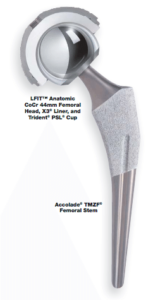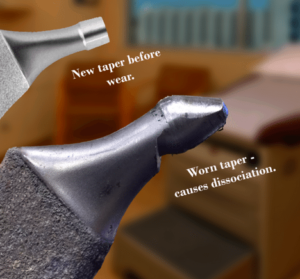 January 17, 2017 — Lawyers for six people who were injured by the recalled Stryker LFIT V40 hip replacement have petitioned judges to centralize the lawsuits in a Multi-District Litigation (MDL) in Massachusetts.
January 17, 2017 — Lawyers for six people who were injured by the recalled Stryker LFIT V40 hip replacement have petitioned judges to centralize the lawsuits in a Multi-District Litigation (MDL) in Massachusetts.
All of the lawsuits accuse Stryker of failing to warn about the risk of side effects when the metal LFIT V40 is combined with a metal femoral stem, which creates a metal-on-metal hip replacement.
In November 2016, Stryker recalled about 42,500 of the LFIT Anatomic CoCr V40 femoral heads that were sold between 2002 and 2011 due to the risk of taper lock failures.
Taper lock failures occur when the “ball” part of the hip — in this case, the LFIT V40 — disconnects from the femoral stem due to a worn-out metal part called a trunnion.

Taper Lock Failure
The number of lawsuits has grown steadily since August 2016, when Stryker issued an urgent warning about the risk of limited mobility, pain, inflammation, tissue death, bone fractures, joint instability, metal poisoning, leg length discrepancy, and revision surgery.
Most recently, a lawsuit (PDF) was filed by a man from Fairbanks, Alaska named Patton Witt. He had his left hip replaced with the LFIT V40 and an Accolade TMZF femoral stem in March 2008.
When he developed high levels of cobalt in his bloodstream (metallosis) and an MRI found a large soft tissue mass, doctors said it was likely due to corrosion between the LFIT V40 and Accolade stem.
During revision surgery in January 2015, even more problems were discovered. His surgeon found corrosion, inflammatory changes, adverse local tissue reactions, worn-out metal parts, and he wrote:
“One could clearly see extensive corrosion present at this site. There appeared to be some deterioration at the trunnion with loss of the passified layer.”
Deterioration of the trunnion — also known as trunnionosis — can cause taper-lock failures and metal poisoning. It occurs when metal grinds off due to the LFIT V40 and Accolade rubbing together.
The only way to fix the problem is by removing the femoral stem and pounding a new one into the patient’s femur, which is physically traumatic (especially for older patients) and often results in one leg being shorter than the other.
The case was filed in the U.S. District Court for Alaska on January 12, 2017 — In RE: Patton Witt, et al. v. Howmedica Osteonics Corp. — Case No. 4:17-cv-00001.
Need a Hip Implant Lawyer in Texas?
Collen A. Clark is a true advocate for his clients and is passionate about helping Texans that have been injured or wronged.
Collen’s amazing success in the courtroom and well known dedication to his clients has earned him the recognition of his peers as one of The Top Trial Lawyers in Texas.”
The Clark Firm has assembled a team of trial lawyers with more than 100 years experience, participation in over 600 jury trials and $260 million in verdicts and/or settlements. Please use the form below to contact our Texas hip implant lawyers for a free lawsuit review.


 To contact us for a free review of your potential case, please fill out the form below or call us toll free 24 hrs/day by dialing:
To contact us for a free review of your potential case, please fill out the form below or call us toll free 24 hrs/day by dialing: